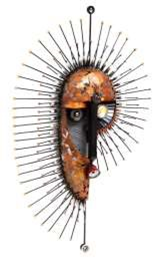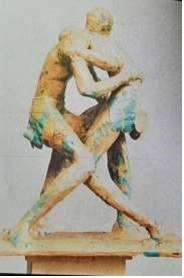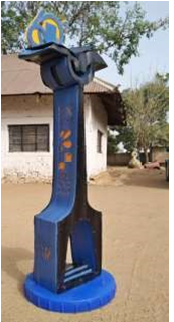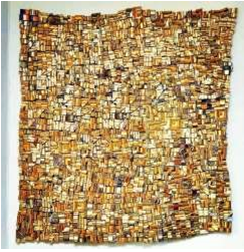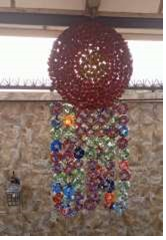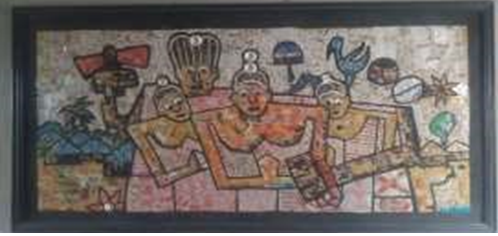Mitigating Environmental Degradation: The Integral Contributions of Young Nigerian Artists and Design Engineers
- Oligbinde, S.R.
- Adesiji O.P.
- Orelaja O.A.
- Solomon O.I.
- Adetoyinbo A.S.
- Onigbara V.B
- 1003-1010
- Oct 8, 2023
- Environment
Mitigating Environmental Degradation: The Integral Contributions of Young Nigerian Artists and Design Engineers
Oligbinde, S.R. 1, Adesiji O.P. 1, Orelaja O.A. 2, Solomon O.I. 1, Adetoyinbo A.S. 1 and Onigbara V.B2
1, Department of Art and Industrial Design, Moshood Abiola Polytechnic, Abeokuta, Ogun State, Nigeria.
2, Department of Mechanical Engineering, Moshood Abiola Polytechnic, Abeokuta, Ogun State, Nigeria.
DOI: https://dx.doi.org/10.47772/IJRISS.2023.70987
Received: 15 August 2023; Revised: 05 September 2023; Accepted: 11 September 2023; Published: 08 October 2023
ABSTRACT
The environment suffers incalculable damage that threatens its existence from wastes generated from human activities. The prevention of this likely self-destructive process must become the concern of all human. This paper examines the roles of young Nigeria Artists and design engineers in various fields in curbing the menace of this pollution; highlights few works produced through such experimentations as well as content analysis of the aesthetic and utilitarian products. Data collected were gotten from interviews, field observations and literatures of the works, artists, and research works as well as photographs of similar artefacts.
Keyword: Wastes, Environment, Recycling, Aesthetics, Artefacts.
INTRODUCTION
Since the advent of urbanization, the issue of waste in the environment, and its impact on the socioeconomic, cultural and political context of any nation resurges with fresh challenges even at a global level with increasing vibrancy (Ajiboye, 2012). This resurgence is critical to health and life discourses everywhere. These discourses have often been polarized along so many ideological and racial lines bothering on conceptual and political issues and problems of patriarchal influence, the scope of waste disequilibrium across regions and geographies, the dynamics of required political action; the possibility and implications of unawareness towards solving this menace. Sadly, majority of the discussion had in Nigeria is predominantly on politics (Greg, 2020, Awoyera and Adesina, 2020), this has led to stepping aside major issues that are pivotal to resolving waste issues in the nation. It is refreshing therefore, that one of our major challenge is subtly gaining our attention again.
Wastes in general is being generated at increasingly alarming rates, resulting in the increased need of environmental, social, and economical conscious management strategies on a global scale. Waste pollution is the accumulation of discarded objects in an environment whereby degrading the healthy standards of the habitats of that environment which includes plants, animals and humans. Nigeria, according to a United Nations Industrial Development Organization (UNIDO) report, generates some 32 million tons of waste per year, 2.5million tons of this is plastic waste. (Emiene, 2022).
Accumulation of wastes near residential buildings, businesses, industrial enterprises, road networks, and in natural environments not only can have an adverse effect on human health and safety but can also greatly alter the aesthetic appeal of our city. Although the aesthetic unpleasantness of wastes does not directly cause harm, it could potentially become a cause of frustration and have an economic cost on the residents (Culler, 2012).
This paper aims to examine the efforts that have been made by artists and engineers in taming the devastating harm that can be caused by wastes and raising an advocacy by all and sundry to rise to the occasion of patronage and utilization of art and technology innovations produced from waste items around us.
BRIEF HISTORY OF WASTE EXPLORATION
Henri Matisse was one of the first to depart from the classic method of applying paint onto canvas. While he is known for his “traditional” paintings, towards the very end of his life he broke away from this and pulled out the scissors. With the help of a large crew of assistants, Matisse created what were known as the cut-outs. For these cut-outs, he and his crew hand-painted white paper using brightly colored gouache paints, then proceeded to cut these painted papers into simple geometric and organic shapes (Whetto, 2019). These cut-out pieces were then both pasted onto canvases and paired with other materials such as charcoal or, for the first time in art history, pinned directly onto the walls of the museum or gallery. Some of his works are: ‘Memory of Oceania’, 1952-53. Gouache on paper, cut and pasted, and charcoal on paper, mounted on canvas 112’’ x 112”. “Along with Picasso, Braque made some of the first collages in art history, also known as papiercolle. As part of the development of Cubism, Braque introduced other materials and patterns onto his canvases, suggesting the subject through the use of found flat materials instead of describing the subject-matter through paint. This may seem like a simple idea, or resemble an art project you did with your kindergarten teacher, but it was a true innovation at the time. This idea soon evolved and inspired other artists to further explore it by introducing three dimensional objects in their works.” (Tenora, 1913)
The establishments of Tertiary schools and institutions between 1950s and 1960s in Nigeria caused a revolution for experimentation and exploration in Nigerian Art. The first formal school of Art was Nigeria college of Art, science and Technology (Now Ahmadu Bello University, Zaria), Mount, (1973;132) narrates that at the beginning of school, expatriates were tutors, and basically commercial design and painting were taught in the school. The Zaria school of 1960s was a Catalyst, popularly known as (Zaria Rebels). The Zarianist, abandoned the western technical instructions, preferring to draw from art Forms, indigenous into their cultural backgrounds.
Having realized that Art and design in engineering is an expression of one’s ideas of feelings without dependencies on the materials used, their successful argument was that art can be done and understood from cultural context of that particular society. (Fosu, 1986) stated that, they are also providing what Uche-Okeke refers to as “Artistic value that encompasses native artistic and engineering sense”, by experimenting with New visual images that are derived from traditional African aesthetic sources. So, the Zarianist started the Art of experimenting and exploring new Art made up of the New and old media.
Oligbinde (2019), asserts that, waste sculpture is increasingly becoming visible on the web, fine art galleries, and in art shows. Waste sculpture is not just about attaching bits of memorabilia to each other, but, as explained by Whetto, (2019) contemporary waste artists often amuse, chide, and tease the viewer by combining totally disparate or incongruous elements in a work or use the objects to soothe, tell a personal story in a kind of code, or imbue the objects with a whole new association and meaning. Once an artist grows interest in using found materials and wastes to create art he will be amazed at the number of useful waste materials which presents themselves for his creative attention.
MODERN NIGERIAN ARTISTS AND ENGINEERS EXPLORING WASTE AS AN ART MEDIUM
Noteworthy among waste experimenting/exploratory artists are El Aantsui, Lanre Tejuoso, Adeola Balogun, Kehinde Badaru, John Adenle, Dotun Popoola, Samuel Anyanwu, Ayo Adewunmi, Segun Okewunmi, Rotimi Oligbinde, Oseghale Marcellina and a host of others (Oligbinde et al, 2023, Adesiji et al, 2023). Ayo Adewunmi works with a variety of media. In 2005, he initiated the ‘Art is everywhere”, a waste to-art recycling workshop. His works featured in an exhibition in 2010 titled “He is building You up” an installation of an uncompleted building made up of discarded drink’ cans, symbolizes the stress and hustle one passes through to have shelter, creating awareness for housing and giving hope to people. (Adewunmi, 2015). Boris Abbas who hails from Cotonou in Benin republic and lives in Badagry in Nigeria. One of his artworks was made with discarded soft cans, which takes the form of a dress with the back of the dress depicting a woman’s face. El Anatsui also used “soft cans” to make drapes inform of cloth. Another piece of such is one titled “Gravity of Grace” (2016), which is also an exploration of soft cans as a medium of expression in painting by Aderogba Rotimi, to depict a Yoruba god Sango.
On the part of engineers, alot has been done ranging from fabrications from recycled metals, plastic bottles, paper etc as well as creating awareness for a safer environment. Mathenge (2016) submits that the results of experimentations in the field of engineering include combining virgin pulp (typically from wood chips) with recycled pulp, to produce newsprint and other recycled-paper products that meet all strength and aesthetic requirements. Today, more than 70% of the newsprint in the world is collected for reuse, significantly reducing both the disposal burden on landfills and the environmental costs of harvesting virgin wood. In the same vein, because of chemical-engineering innovations, plastics are separated by machine and reprocessed without significant material breakdown, enabling reuse of many such plastic products as pipe, toys, and decorations (Brendan et al, 2022)
CONTENT ANALYSIS OF SELECTED ARTWORKS MADE FROM WASTE MATERIALS
Meanwhile, various ideas and techniques of waste exploration in art were discovered from practicing artists, which were mostly used as media in painting and also in other genres of the visual arts. According to (Ajiboye, 2012), the history and views of these artists’ works in this technique has stood the test of time in durability, sustainability and beauty; it has also attracted people across the world through exhibitions and some other showcase outlets as well as social media platforms. Few of such works are examined below:
Plate 1: Ojelade Quadri, Olojukan, 24”by36”, discarded metal and alluminium, 2022.
Photograph by: Akinrinola Ayooluwa, 2022.
Olojukan
The above work describes a personality who underestimates his life, until he meets people lowlier than he is, before he truly understands the value of himself. Even in the face of in capabilities, challenges, disabilities, unrest and others, stay positive and grateful. The object at the fore head is like a glory man keeps running after and never get to acquire. Its invisible, it’s a mere illusion but man always strive his best to been seen and counted among the notables but never get to that glory. The mask is a mixture of motor spark plugs, rod, mental sheet, carbonated wire, spring, cone and aluminum.
Plate 2: Dotun Oluwa, Wrestling, Rumbled Paper, 36”by 36”, 2017.
Photograph by: Oridola Ibrahim, 2022.
Wrestling
Dotun Oluwamade this piece out of discarded rumbled carton paper. The two figures represent two fighters in a wrestling combat. This incredible realism is modelled entirely on rumbled paper and imitate the Nigeria’s brutal boxing Art of Dambe. Dambe is a martial art organized among the Hausa people of Nigeria. It is a traditional combat sport, an ancient sport where broken jaws or ribs are the signs of victory. Its origin is dated back as at the 10th century, but over the years it has attracted more viewers worldwide. They were depicted locking hands and in an intense battle for supremacy, being shirtless with boxers shorts underpants. The piece originally depicts a traditional African wrestling event.
Dotun Oluwa is another Nigerian artist in the pedigree who converts junks into astonishing works of art with high aesthetics and intriguing narrative. He is famous for his creative manipulation with rumbled paper and correct anatomy of forms. Each iteration of his work is followed with intriguing body composition, drama and ideas which always viewers’ attention in traditional village square.
Plate 3: Adesanya Clement, Chapter 60 (OAU@60), 108”by5”, discarded plastic, 2021.
Photograph by: Adesanya Clement, 2021.
Chapter 60 (OAU@60)
The piece is dedicated to Great Ife (University of Ife/ Obafemi Awolowo
University, Ile-Ife) unveiled in an Art Exhibition to commemorate the sixty years of establishment of the institution. “Chapter 60” sculpture was conceived using one of the iconic structure on O.A.U Campus (Entrance Arcade to University Hall). The composition comprises of sixtieth logo, a book and the O.A.U iconic structure: a voluminous book placed on the iconic structure, the open book has the sixtieth anniversary logo attached to it by the left hand side depicting the “sixtieth chapter” of the book while more volumes are to the right hand side, metaphorically “more chapters (years) to advancing knowledge”. There is interplay of Ona motif and diamond pattern on the side of the iconic structure creating positive and negative space with the university colour mind (midnight blue and Gold) blue and yellow polyethylene water tank was use.
The black polyethylene represents the culture, the foundation and motto of O.A.U., For Learning and Culture. The media in the sculpture are polyethylene tank fastened with copper wires and screws. The waste plastic employed has mechanical strength to demonstrate the required resilience, though broken and no more fit for manufacturer’s design yet artists have redeployed it, the same way, mechanically recycled plastics can be incorporated into cementitious composites as aggregates and fillers due to their hardness and stability (Awoyera and Adesina, 2020; Sathanandam et al, 2017; Murthi, 2018).
Plate 4: Egunjobi George, Iyani Wura, (Mother is Gold), 52”by52”, discarded frame cut out and wire, 2021
Photograph by: Egunjobi George, 2022.
Iyani Wura (Mother is Gold)
There is a popular saying in Yoruba land that goes thus: “Iyani Wura” meaning “Mother is Gold”. The role and position of mothers in our society cannot be overlooked. Life givers, caregivers, protectors, nurses, several multiple roles embedded in one being. The role of mothers cannot and should not be compromised at all. The multi-tasking role they play makes them the superhuman that makes our lives easy the way it seems. A woman’s role is multidimensional in Yoruba culture- a mother, a wife. A daughter, priestess, or even a witch. The way she is perceived depends on the position she occupies, and the different perceptions are reflected through songs, works of art, music, language and religion. The highest value is given to a mother because Yoruba people revere motherhood.
One would have noticed the enormous gold colours in the above work. It depicts the value of motherhood i.e. their essentialness. Meaning she is gold, she emits gold and sees others as gold as she is she. They add colour and fragrance to everywhere they go. The fact that the work is not entirely covered in gold, both has a mixture of other colours, connotes the facts that no matter the race of the mother, all mothers has one thing in common which is the heart of gold.
Plate 5: Olarenwaju Tejuosho, Adorin (70th), discarded metal and discarded nylon, 72”by 36”, 2022.
Photograph by: Oligbinde Rotimi, 2022.
Adorin (70th)
Interested in a clean environment far beyond aesthetics, Olarenwaju is concerned with the ethical treatments of waste in the environment, especially when it comes to improper disposal of wastes. He began sculpting impeccable cut pieces of waste nylon as way of protecting his surroundings. The mixed media is a work created to commemorate the 70th birthday anniversary of Prince Yemisi Shyllon, who is the highest private individual art collector in Nigeria and Africa. Shyllon’s enthusiasm and efforts to promote artists and the art course, prompted Olarenwaju to dedicate this artefact to his platinum jubilee.
Plate 6: Aderogba Rotimi, Sango, discarded aluminum, 36”by 72”, 2015.
Photograph by: Adeyemi Oba, 2022.
Sango
Popularly known as the god of thunder, is associated with fire and lightning. His prominent symbol is the Oshe, a double-headed battle axe, which is prominent among the priests and adherents of Sango. During celebration, outing or dancing, the priest shold the oshe very close to their chests, serving as a protection or swing it in a wide chest-high arc. The Bata drum is the prominent drum specifically selected by Sango to be drummed during his reign, the drum which was specifically meant to summon the storms.
The steel-hard nature of the personality of Alaafin Sango explains the motive behind the choice of metal as medium of expression by the artist.
CONCLUSION
The paper has highlighted the hazardous effects of wastes to the earth and her dwellers, thereby raised an advocacy for collective action – geared towards reusing, reducing and recycling of intended waste elements. In addition to the aesthetic artefacts discussed above, other utilitarian products have been produced as a result of experimentations; waste nylon has been employed in artistic and engineering artefacts, the study by Ji Ming and Wen (2018) found that nylon wire can effectively improve the high temperature stability, low temperature crack resistance and moisture susceptibility of SMA. Also, oil absorption, adhesion and the retarding effect of waste nylon wire on the crack propagation of asphalt mixture are attributed to the reinforcing mechanism. As technology advances, new need arises, the world must be on the look-out for new methods and techniques to remodel waste materials so as not tame climate change resulting from indiscriminate or zero waste control.
The culture of recycling must be inculcated in our day to day activities and consciousness. People should now view this as their first corporate social responsibility which they owe the society. Parents and guardians should not only teach but show their children how to properly dispose waste in the environment.
REFERENCES
- Adesina A., Overview of the mechanical properties of concrete incorporating waste from the concrete industry as aggregate, J. Curr. Constr. Issues. 3 (2018) 23–25.
- Adewunmi, A., (2015). Evolving Tradition of Waste-to-Art: The Nigerian Experience. Journal of Institute of Management and Technology, Enugu, Nigeria.
- Ajiboye, O. (2012). Bottle tops as a Medium of Expression in Painting, Unpublished MFA Project Report; Ile-Ife: Department of Fine and Applied Arts, Obafemi Awolowo University, Ile-Ife, Osun State, Nigeria.
- Awoyera P.O., Nonlinear finite element analysis of steel fibre-reinforced concrete beam under static loading, J. Eng. Sci. Technol. 11 (2016).
- Culler, J., (2012). Art and the Detritus of Nigerian Life: An Essay on Olu Amoda’s Cequel, in Pogosun, O.I. (e.d), Shattering the barriers of Artistic Conventions. Ibadan: Institute of African Studies, 2021, pp. 69-82.
- Emiene, E., (2022). Waste to Wealth: The Women at the Heart of Bottle recycling in F.C.T.
- Greg, O., (2020). Harnessing Environmental Wastes for Cleanliness, The Punch, Thursday, August 20, 2020.
- Murthi P., Awoyera P., Selvaraj P., D. Dharsana, R. Gobinath, Using silica mineral waste as aggregate in a green high strength concrete: workability, strength, failure mode, and morphology assessment, Aust. J. Civ. Eng. 0 (2018) 1–7, doi:http://dx.doi.org/10.1080/14488353.2018.1472539.
- Oligbinde, S., (2019). Exploration of plastic waste as a vehicle for Environmental Protection in Sculpture. Unpublished M.F.A Project Report; Ile-Ife: Department of Fine and Applied Arts, Obafemi Awolowo University, Ile-Ife, Osun State, Nigeria.
- Sathanandam T., Awoyera P.O., Vijayan V., Sathishkumar K., Low carbon building: experimental insight on the use of fly ash and glass fibre for making geopolymer concrete, Sustain. Environ. Res. 27 (2017), doi:http://dx.doi.org/10.1016/j.serj.2017.03.005.
- Tenora, W., (1913). Paper colle’ introducing three-dimensional objects in their works, (Retrieved on January 14, 2019).
- Whetto, B., (2019). Transition. A Master of Fine and Applied Art Solo Exhibition of Painting, Drawings and Mixed Media, held at Obafemi Awolowo University, Ile-Ife, Osun State, Nigeria, 2019.
- Oral interview with Mr. Adesanya Clement, Abeokuta, Ogun State, 2022.
- Oral interview with Tejuoso Lanre, Abeokuta, Ogun State, 2022.
- Oral interview with Ojelade Quadri, Ile-Ife, Osun State, 2022.
- Oral interview with Dotun Oluwa, Lagos State, 2022.
- Oral interview with Egunjobi George, Abeokuta, 2022.
- Oral interview with Aderogba Rotimi, Ile-Ife, Osun state, 2022.

